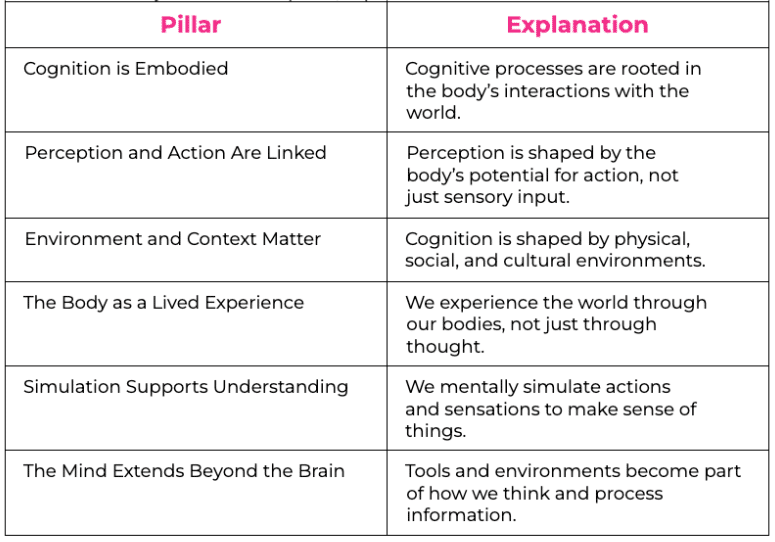Have you ever noticed how your shoulders rise when you’re stressed, or how you clench your jaw during tough conversations? These unconscious habits are more than quirks. They’re clues to how your mind and body are connected.
Embodiment theory is the idea that our thoughts, emotions, and behaviors are not just mental; they are deeply connected to how we physically experience the world. This body-centered awareness supports healing from trauma, enhances self-awareness, and improves emotional regulation and stress management. Let’s break it down.
What Is Embodiment Theory?
Embodiment theory simply explores why we are the way we are through the connection between the mind and body1. It is the idea that we use our bodily experience to understand our own emotional experience, and the experiences of others2.
We asked Jessica Aronson, LCSW-R, ACSW, CGP, CEDS-C, an expert in embodiment practice, to weigh in. “To me, Embodiment is a felt sense that includes one’s mind, body, soul, and spirit. The combination of sensory input, emotional and physical signals and feedback, allows for an embodied experience with oneself.”
The Six Pillars of Embodiment
Embodiment theory draws from six pillars, explained in the table below:

How Embodiment is Used in Practice
Embodiment is a powerful practice that invites presence and awareness, often embraced with various healing and therapeutic spaces. Through embodiment, we deepen our awareness of how emotions move through the body, creating space for healing and integration of past emotional wounds and trauma. This gentle practice can also support those on the path of recovery from eating disorders, helping to rebuild trust and connection with the body.
In the journey of healing from eating disorders, reconnecting with the body is a vital step toward recovery. Many therapeutic approaches now incorporate somatic practices to help individuals cultivate safety and awareness within their own physical experience. Aronson, who works closely with clients navigating eating disorder treatment, explains:
“I utilize different somatic approaches, tools, and skills which allow clients to learn how their nervous system and body respond to feedback. For example, a client may work with a weighted blanket or hold a fidget while someone else prefers aromatherapy. Pairing somatic awareness and psychoeducation can support clients learning how to take care of themselves in new ways. The goal is to support clients in feeling social safety, which supports regulation during the session.”
By blending body-based tools with nervous system education, practitioners like Aronson help clients rebuild trust in their bodies and discover new pathways to self-regulation and nourishment, physically, emotionally, and energetically.
Dr. Ann Saffi Biasetti, author of Befriending Your Body, is a seasoned psychotherapist who uses embodiment not to “fix” the body, but to honor it as a sacred path to awareness and healing3. She invites clients to explore the body as a source of wisdom, helping them reconnect in a world that often encourages disconnection through stress, social media, and diet culture. She writes,
“Your body is your informant. If you listen deeply, it will tell you what you need to know to keep yourself moving toward strength and wellness.”4
Similarly, Dr. Cynthia Price, a researcher and somatic therapist, developed Mindful Awareness in Body-Oriented Therapy (MABT) to support those healing from trauma, addiction, and chronic pain. Her approach weaves together body awareness, emotional regulation, and the gentle release of dissociation. As Dr. Price explains, interoceptive awareness, the ability to identify and interpret internal bodily sensations like heart rate, breathing, muscle tension, and hunger, can offer new pathways of care, especially for those who’ve been taught to turn away from the body rather than toward it5.
Dr. Ann Saffi, PhD, and Dr. Cynthia Price, PhD, have influenced our approach at Laura Cipullo Whole Nutrition Services through their work with embodiment and MABT. Laura is currently completing her Level 3 Advanced Training internship in MABT and plans to complete all four trainings, while Paige receives supervision from Dr. Saffi.
Everyday Practices You Can Try
There is no reason to wait to practice embodiment strategies. Aronson suggests these simple ways to begin on your own:
- Upon waking up, ask yourself, “how do you feel?” “What do you notice in your body?”
This practice, before getting out of bed, plugs you into your body. It signals that you are paying attention to cues and clues. The simple act of identifying sensations or signals such as, “I am tired”, “my legs feel sore”, “I feel scared about the test today”, and “I have a belly ache”, allow you to see yourself. This practice can spread throughout one’s day with all relationships including food, mood, and movement.
- When you get home before walking into your residence, ask yourself, “What is happening in my body, right now, before I open the door?”
The more aware we become about our present moment states, the better we can navigate the experience on the other side of the door, at home.
Summary
Embodiment is a gentle somatic practice that can help guide rediscovery between your body and mind. By tuning into your body’s subtle cues, like tension, breath, posture, you begin to reconnect with your inner world. Embodiment isn’t just a theory; it’s a daily practice that invites healing, clarity, and presence.
Ready to begin your own embodiment journey? Connect with one of our registered dietitians to explore healing through body-based awareness and care.
Resources for Embodiment Practice
Arriving in Embodied Presence | A Guided Meditation from Tara Brach
Meditation: Arriving in Embodied Presence (23:59 min)
Embodied Presence: Reconnecting with Our Bodies (Part 1)
Sources
- Walsh, M. (2013a, August 1). What is embodiment and why does it matter?. YouTube. https://www.youtube.com/watch?v=JYacDPOWsmE
- Zibrek, K., Reggin, L., & de Gelder, B. (2019). Embodiment of emotion throughout the lifespan: The role of multi-modal processing in perception, cognition, action, and social and emotional functioning [Editorial]. Frontiers in Psychology.
https://www.frontiersin.org/research-topics/8911/
- Asadis. (2025). Eating disorders: How neurobiology, embodiment and self-compassion heal [Online course].
https://asadis.net/en/course/eating-disorders-through-embodied-view-neurobiology/ 4. Biasetti, A. S. (2018). 4 – Becoming Embodied. In Befriending your body: A self-compassionate approach to freeing yourself from disordered eating (p. 72). essay, Shambhala.
- Center for Mindful Body Awareness. (n.d.). About MABT. In Mindful Awareness in Body‑oriented Therapy. Retrieved July 24, 2025, from
https://www.cmbaware.org/about-mabt/








